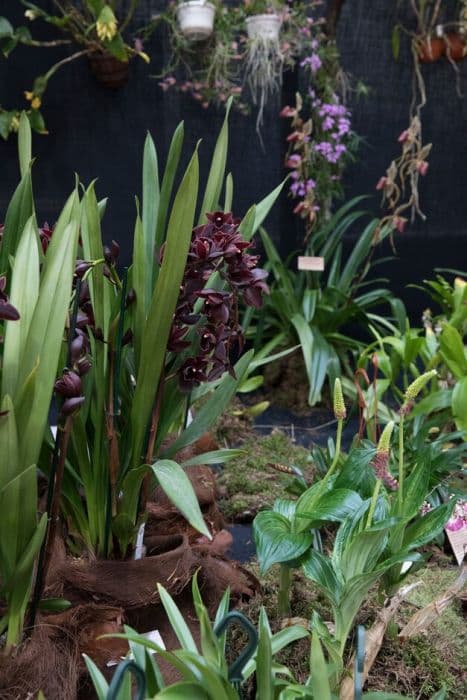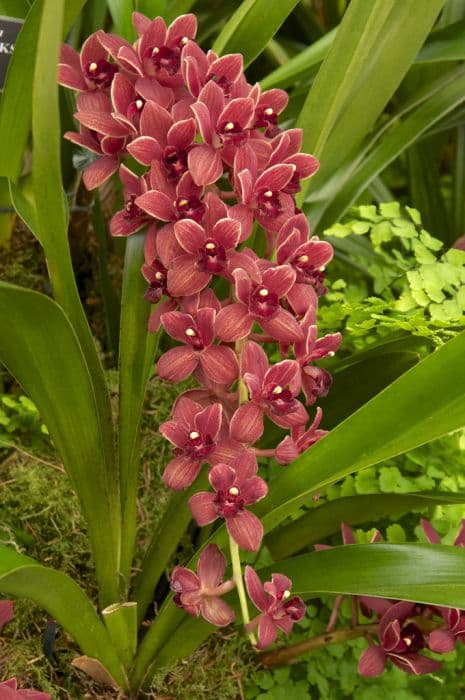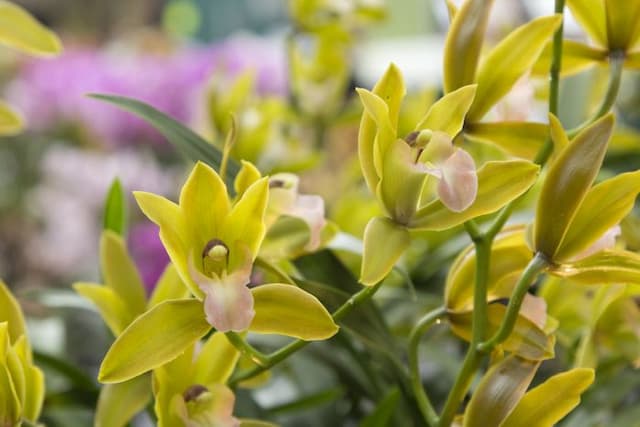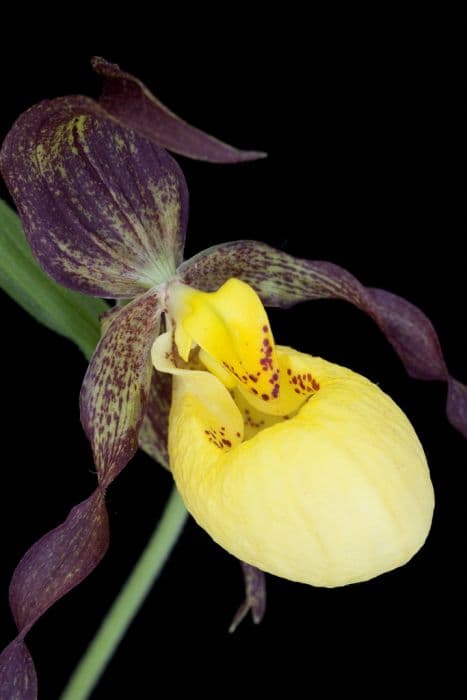Cockleshell Orchid Prosthechea cochleata

ABOUT
The cockleshell orchid is an intriguing and attractive plant recognized for its unique floral structure and overall beauty. It blooms with striking flowers that feature an upside-down orientation, making them stand out from many other orchid varieties. The blossoms usually come in shades of green, purple, and white, creating a highly appealing contrast against the backdrop of the foliage. At the heart of each flower, there is a prominent, lip-like petal that often boasts a deeper purple or maroon hue, intensifying the orchid's exotic allure. The petals and sepals are elongated and can sometimes have a slight twist, adding to the distinctive, cascading effect of the blooms. Below the larger petal, a slender, extended spur is noticeable, contributing to the flower's unique "cockleshell" appearance. The plant's leaves are quite striking as well – they are typically tough, leathery, and emerge in a pair or a small cluster from the base. These leaves are a bright green color that persists throughout the year, offering a continuous display of lush vegetation which nicely complements the periodic shows of the orchid's remarkable flowers.
About this plant
 Names
NamesSynonyms
Cockleshell Orchid, Clamshell Orchid, Octopus Orchid.
Common names
Anacheilium cochleatum, Encyclia cochleata, Epidendrum cochleatum.
 Toxicity
ToxicityTo humans
The plant Prosthechea cochleata, commonly known as Cockleshell Orchid, is not considered toxic to humans. There are no well-documented cases or reports that suggest the ingestion of any part of the Cockleshell Orchid causes poisoning or produces harmful symptoms in humans.
To pets
The plant Prosthechea cochleata, commonly referred to as Cockleshell Orchid, is not known to be toxic to pets. Pets, such as dogs and cats, that ingest parts of this orchid do not typically exhibit signs of poisoning or experience adverse health effects as a result of their interaction with the plant.
 Characteristics
CharacteristicsLife cycle
Perennials
Foliage type
Evergreen
Color of leaves
Green
Flower color
Greenish-yellow
Height
1-2 feet (30-60 cm)
Spread
1-2 feet (30-60 cm)
Plant type
Orchid
Hardiness zones
10
Native area
Americas
Benefits
 General Benefits
General Benefits- Ornamental Value: The Prosthechea cochleata, commonly known as the Cockleshell Orchid, is admired for its unique and striking flowers, making it a popular choice for ornamental decoration and collection.
- Ecological Role: This orchid plays a role in its native ecosystem, serving as a host plant for specific pollinators and contributing to biodiversity.
- Habitat Conservation: By cultivating Cockleshell Orchids, enthusiasts and botanists help to preserve this species, which in turn aids in the conservation of orchid habitats and ecosystems.
- Scientific Study: Prosthechea cochleata has been a subject of research in the areas of botany and horticulture, providing insights into orchid biology, propagation, and hybridization.
- Educational Value: The intricate life cycle and unique adaptations of the Cockleshell Orchid offer educational opportunities for teaching about plant biology and the importance of conservation.
 Medical Properties
Medical PropertiesThis plant is not used for medical purposes.
 Air-purifying Qualities
Air-purifying QualitiesThis plant is not specifically known for air purifying qualities.
 Other Uses
Other Uses- The Prosthechea cochleata, commonly known as the Cockleshell Orchid, is often used in hybridization to create novel orchid varieties with unique shapes and colors. Hybridization expands the diversity within the orchid family.
- Enthusiasts may utilize the Cockleshell Orchid in photography and art due to its distinctive spiraling petals and striking appearance, making it a fascinating subject for various forms of artistic expression.
- The plant is occasionally used as a botanical model in educational settings to demonstrate the complexity of orchid pollination mechanisms to students and orchid enthusiasts.
- Some cultures incorporate the Cockleshell Orchid into traditional ceremonies and offerings, valuing its aesthetic appeal and rarity.
- In horticultural shows and competitions, Prosthechea cochleata is a frequent entry where it may be judged for its unique shape, color, and overall presentation.
- The long-lasting flowers of the Cockleshell Orchid make it a popular choice for inclusion in floral arrangements and decorations at events and public spaces.
- Gardeners may use the Cockleshell Orchid as a companion plant in orchidariums, where its particular growing needs can create a microclimate beneficial to other nearby orchids.
- The Prosthechea cochleata can serve as a living gift that symbolizes luxury and exotic beauty, often given on special occasions like anniversaries or milestones.
- Because of their intricate structure, the Cockleshell Orchid flowers can inspire designs and patterns in fields such as fashion, textiles, and home decor.
- Conservation programs may feature the Cockleshell Orchid as an example of a species that is adaptable to different habitats, contributing to the discussion on biodiversity and the importance of preserving various orchid species.
Interesting Facts
 Feng Shui
Feng ShuiThe Cockleshell Orchid is not used in Feng Shui practice.
 Zodiac Sign Compitability
Zodiac Sign CompitabilityThe Cockleshell Orchid is not used in astrology practice.
 Plant Symbolism
Plant Symbolism- Uniqueness: Prosthechea cochleata, commonly known as the Cockleshell Orchid, has a unique flower shape that stands out among other orchids, symbolizing distinctiveness and the beauty of being different.
- Mystery: Orchids are often associated with mystique and exotic beauty, and the Cockleshell Orchid's unusual appearance enhances this symbolism, representing enigma and the allure of the unknown.
- Rarity: As a less common orchid, the Cockleshell Orchid can symbolize rarity and value. It may be given to convey a sense of preciousness and esteem for something or someone unique.
- Love: Orchids in general are symbols of love and fertility; the Cockleshell Orchid may represent a deep, sometimes secretive love, with its intricate flowers emanating an intimate charm.
 Water
WaterThe Cockleshell Orchid should be watered once a week by soaking, allowing excess water to drain freely. During active growth in the warmer months, you may increase watering to twice a week but always allow the medium to dry slightly between waterings. On average, use about one quart of water for a medium-sized plant at each watering session. Ensure that in the cooler or dormant months, you reduce the watering frequency to prevent root rot.
 Light
LightThe Cockleshell Orchid thrives in bright, indirect light with partial shade. Avoid placing it under direct sunlight, which can scorch the leaves. A north or east-facing windowsill is often an ideal spot to provide the light conditions it prefers. If growing outdoors, dappled light under a canopy or a shade cloth that filters sunlight is beneficial.
 Temperature
TemperatureThe ideal temperature range for the Cockleshell Orchid is between 50 and 80 degrees Fahrenheit. They can withstand minimum temperatures of about 55 degrees Fahrenheit at night and maximum temperatures of around 90 degrees Fahrenheit during the day. Consistently maintaining the temperature within this range will support healthy growth and flowering.
 Pruning
PruningPruning of the Cockleshell Orchid is generally not necessary except for the removal of dead or damaged foliage and spent flower spikes to maintain a tidy appearance. This can be done at any time of the year as needed. After flowering, cut the flower spike close to the base to promote new growth.
 Cleaning
CleaningAs needed
 Soil
SoilThe Cockleshell Orchid thrives in medium to fine-grade bark mixes with good drainage. A recommended soil mix is a combination of bark, perlite, and charcoal. The ideal soil pH for Prosthechea cochleata should be slightly acidic to neutral, typically between 6.0 and 7.5.
 Repotting
RepottingThe Cockleshell Orchid should be repotted every two to three years, or when the potting medium starts to decompose. It's best to repot in the spring after the flowering period.
 Humidity & Misting
Humidity & MistingThe Cockleshell Orchid prefers high humidity levels, ideally between 50% to 70%. Consistently high humidity is crucial for its optimal growth and blooming.
 Suitable locations
Suitable locationsIndoor
Place in bright, indirect light; maintain high humidity.
Outdoor
Filtered light; protect from extreme temps; high humidity.
Hardiness zone
10-11 USDA.
 Life cycle
Life cycleProsthechea cochleata, commonly known as the Clamshell Orchid, starts its life as a seed dispersed by wind due to its minuscule, dust-like size. Upon finding a suitable host, often a tree branch where it can receive dappled sunlight, the seed germinates and forms a protocorm, which eventually develops into a small orchid with leaves and aerial roots. This epiphytic orchid enters a vegetative stage, where it focuses on leaf and root growth for photosynthesis and nutrient uptake, respectively. After maturing, the Clamshell Orchid produces unique inverted flowers that can self-pollinate or be cross-pollinated by insects, leading to the development of seed pods filled with countless tiny seeds. The seeds are then released into the air to find new hosts and continue the life cycle. Under optimal conditions, the orchid can regularly bloom, sometimes several times a year, while continuing its vegetative growth.
 Propogation
PropogationPropogation time
Spring-Early Summer
Prosthechea cochleata, commonly known as the Cockleshell Orchid, is typically propagated through division, which is the most popular method. This is best done when the plant has finished flowering, usually in spring or fall. To propagate by division, carefully remove the plant from its pot and gently separate the pseudobulbs, ensuring that each division has at least three pseudobulbs and a healthy root system. Each division should then be potted in a well-draining orchid mix, watering sparingly until new growth appears. This method allows for quick establishment and flowering of the new plants within a year or two.









